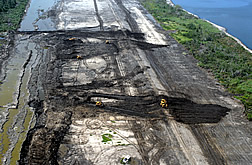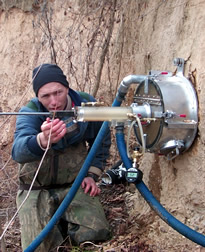|

The erodibility of soils being
used to repair New Orleans levees in the wake of Hurricane Katrina is being
tested to ensure the levees will be able to stand up to future water stress.
Image courtesy U.S. Army Corps of
Engineers (300 dpi).
|
ARS Device Helps Ensure Efficacy of New Orleans
Levees
By Kim
Kaplan October 17, 2006
A device developed by the Agricultural Research Service (ARS) that tests how well soil resists being
eroded by water is helping ensure the efficacy of levees around New Orleans.
The Jet Test Apparatus, designed by
Gregory
J. Hanson, research leader at the ARS
Hydraulic
Engineering Research Unit, Stillwater, Okla., uses a water jet pumping at
various flow rates to give a rapid determination of the erodibility of soil
used in structures like levees.
While the device was originally designed to help evaluate the
potential for soil erosion in stream beds and banks, Hanson and
U.S. Army Corps of Engineers research
civil engineer Johannes L. Wibowo saw the possibility of using the equipment to
test new and existing levees. Wibowo is with the USACE
Engineer Research and Development
Center in Vicksburg, Miss.
|

ARS hydraulic engineer
Gregory J. Hanson, inventor of the jet test apparatus, using the device at a
Mississippi site. Image courtesy G. Hanson; not available in 300 dpi.
|
The levees in New Orleans' East Parish and St. Bernard
Parish—both those that survived Hurricane Katrina intact and those
repaired after failing—provided the perfect place to test their idea.
The ARS
National
Sedimentation Laboratory in Oxford, Miss., which has also been using the
Jet Test Apparatus in stream erosion and sedimentation studies, provided the
device and training to help the Corps of Engineers with the initial testing of
the levees.
Levees that successfully held during Katrina provided a baseline for
acceptable erodibility. Newly repaired levees were matched against that
standard.
Measuring the ability of the repaired levees to resist water erosion
is especially important because the soil being used to rebuild them is from a
number of locations around Louisiana and Mississippi, and the soil's resistance
to erodibility, once placed and compacted, may not be known.
In the past, there has not been an objective way to measure
erodibility, so resistance to erosion has not been included in levee
specifications. A report now being finalized by Wibowo may change that,
enhancing the future safety of levees and dikes.
ARS is the U.S. Department of
Agriculture's chief scientific research agency.